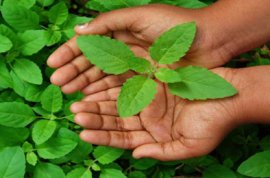
Thulasi Ayurveda

Plant Description
Tulsi in India is ubiquitous in hindu tradition. Tulsi is derived from a Sanskrit word, which means "matchless one". Tulsi is just not implicated in the ayurvedic medicine but also in other medicinal systems like in Greek, Roman and Unani. Its scientific name is Ocimum Sanctum.
It is grown in warm and tropical areas. Tulsi grows fragrantly, erect and with several branches. It can carry the height up to 30 to 60 cm on its maturity. The leaves of the plants are simple, elliptic, oblong with obtuse or acute, entire or subserrate margins. These are present on opposite sites. The leaves of the tulsi are filled with scents as it smells very good. These can be of 5 cm. The flowers of the tulsi are so small with elongated racemes present as in close whorls. These are of purple color. The fruits are very small and seeds are of reddish yellow color.
General Description
Plants are very important source of medicines and drugs. In the plants species or genera, having medicinal properties, genus ocimum which belongs to the lamiaeae family are very important due to their therapeutic actions. Ocimum sanctum consists of two varieties: the black one also known as Krishna tulsi and green known as rama tulsi. Tulsi is a Sanskrit word which means "matchless one".
Tulsi is very old in the medicinal field. It is used for its therapeutic properties since 4000 to 5000 B.C. in rigveda, its reference is present that is in 3500 to 1600 B.C old. It is known as queen of herbs.
This plants is known to have hypoglycemic, smooth muscle relaxant, cardiac depressant, antifertility, adaptogenic, immunomodulator, antibacterial, antifungal, antiviral, anti -diabetic, wound healing, anti-oxidant, genotoxic, anti-carcinogenic, radio-protective, neuro-protective, immunological, contraceptive, cardio-protective and lavricidal properties.
Tulsi is enriched with various phytochemicals. The leaves of the plant contains volatile oil 71% eugenol and 20 % methyl eugenol. The fresh plant parts contain phenolic compounds like isothymusin, apigenin, circimaritin, cirsilineol, rosameric acid. These also consistes of two flavonoids: orientin and vicenin, luteolin, apigenin-7-O-glucuronide, Ursolic acid, apigenin, luteolin-7-O glucuronide, orientin, molludistin, sesquiterpenes and monoterpenes such as elemene, neral, alpha and beta- pinenes, camphene, campesterol, cholesterol, stigmasterol and sitosterol. The essential oil of the plant also contains hydrocarbon caryophyllene4, carvacrol, aplpha, beta-pinene, myrecene, limocene, octane, benzene, p-cymene, terpenol, borneol, cuparene, iedol, elemene, sesquiterpine and more. It also contain vitamins like vitamin C, carotene and minerals like calcium, phosphorus, copper, chromium, zinc, iron, nickel and insoluble oxalate.
Classification
- Kingdom - Plantae
- Subkingdom - Viridiplantae
- Infrakingdom - Streptophyta
- Superdivision - Embryophyta
- Division - Tracheophyta
- Subdivision - Spermatophytina
- Class - Magnoliopsida
- Superorder - Asteranae
- Order - Lamiales
- Family - Lamiaceae
- Genus - Ocimum
- Species - Sanctum
Habitat
It is present in the Himalayas up to 1800 meters above the sea level. It is also grown in all over the country and islands also. It grows abundantly in Malaysia, Australia, West Africa and some of the Arab countries. It is also found in Gir Wildlife Sanctuary and Sasangir National Park.
Names of the Tulsi
- Sanskrit Name – Tulsi, Tulasi, Gouri, Bhuteshta, Bhutaghini, Nagamata, Surasah, Mal-Tulasi, Krsiatulasi
- Hindi Name - Tulsi
- English Name - Indian Basil, Holy Basil, Sacred Basil
- Tamil Name - Nalla Thulasi
- Telugu Name - Tulasi
- Arabic Name - Raihan
- Chinese Name - Lo-Le
- Dutch Name - Basil Icum
- French Name - Basilic
- German Name - Basilïenkraut
- Indonesian Name - Selasih, Kemangi
- Italian Name - Basilico
- Japanese Name - Meboki
- Malay Name - Selaseh, Kemangi
- Philippine Name - Belanoi, Sulasi
- Portuguese Name - Man Jericao
- Russian Name - Bazilik
- Spanish Name - Albahaca
- Sri Lanka Name - Suwenda-Tala, Maduru-Tala
- Swedish Name - Basilkort
- Thai Name - Horopa, Manghk, Krapow, Bai Horapa
- Vietnamese Name - Rau Que
Ayurvedic Properties
| Hindi / Sanskrit | English | ||
| Rasa | Katu, Tikta | Taste | Pungent, Bitter |
| Guna | Laghu, Rooksha, Teekshna | Physical Property | Light, Dry, Piercing |
| Virya | Ushna | Potency | Hot |
| Vipaka | Katu | Metabolic Property (After Digestion) | Pungent |
Effects on Doshas
It helps to balances vata and kapha doshas. It helps to increase pitta dosha.
Classical Categorization
| Charak Samhita | Vagbhata | Sushrut Samhita |
|
Svasahara gana |
Surasadi gana |
Ancient Verse of Tulsi
The Bhavprakash nighantu edition of 1998: verse 62-63, page no-509-510.
It states the names and properties of tulsi. It is known with tulasi, surasa, gramya, sulabha, Bahumanjari, Apetarakshasi, gauri, Bhutaghni and Devadundubhi names.
It is pungent and bitter in taste. It is good for heart, hot in potency. It generates heat in the body and aggravates pitta.
It promotes digestive fire and manages skin diseases, dysuria, blood impurities, chest pain and vata kapha disorders.
Reference
The Bhavprakash nighantu with elaborated Hindi commentary by Padmashri prof. K.C. Chunekar, edited by Dr. G.S. Pandey: Edition of 1998, verse -62 to 63, page no.509 to 510.
Practical Uses of Tulsi
Tulsi show numerous medical properties. It helps to treat cancers, ulcers, inflammations, liver problems and many more.














